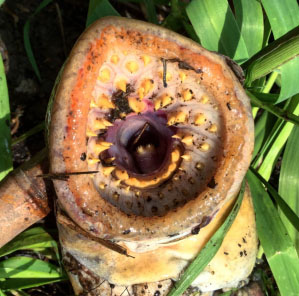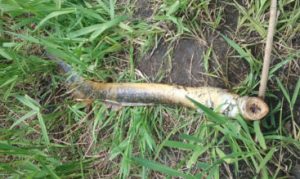This past May, a dead adult sea lamprey was observed at Oliver Mill Park in Middleborough. The fish had migrated up the river to spawn on the Nemasket and having completed its life cycle, died and was washed up on the banks. It was 30” long.
There are two lamprey species native to Massachusetts waters, the American Brook Lampry (Lethenteron appendix) (which is a threatened population in the state) and the Sea Lamprey (Petromyzon marinus).
The fellow found on the Nemasket was a Sea lamprey with its typical yellow spawning pigmentation. Sea lampreys are anadromous, they migrate from the ocean to freshwater to spawn. Sea Lampreys, when they enter the fresh water rivers to spawn, stop feeding, as all their energies are focused on reproduction, so they are not a threat to inland fisheries (like in the Great Lakes region, where Sea Lamprey predation have had a huge impact on restoring local fisheries.) Young lamprey can remain in freshwater for to five years living on the bottom as filter feeders. It is only in maturity, that the lamprey become parasitic, returning to the ocean and live for two years feeding off of other fish species fluids and tissues before returning to fresh water systems to spawn and then die.
There have been some studies of the Sea Lamprey populations in the Connecticut River Watershed. The fact that Sea Lampreys are present in the Taunton River watershed is an indication of the river system’s improving health.
Link to Mass Div. of Fisheries & Wildlife fact sheets on Sea Lamprey:
https://www.mass.gov/eea/agencies/dfg/dfw/fish-wildlife-plants/fish/petromyzon-marinus-2015.pdf

